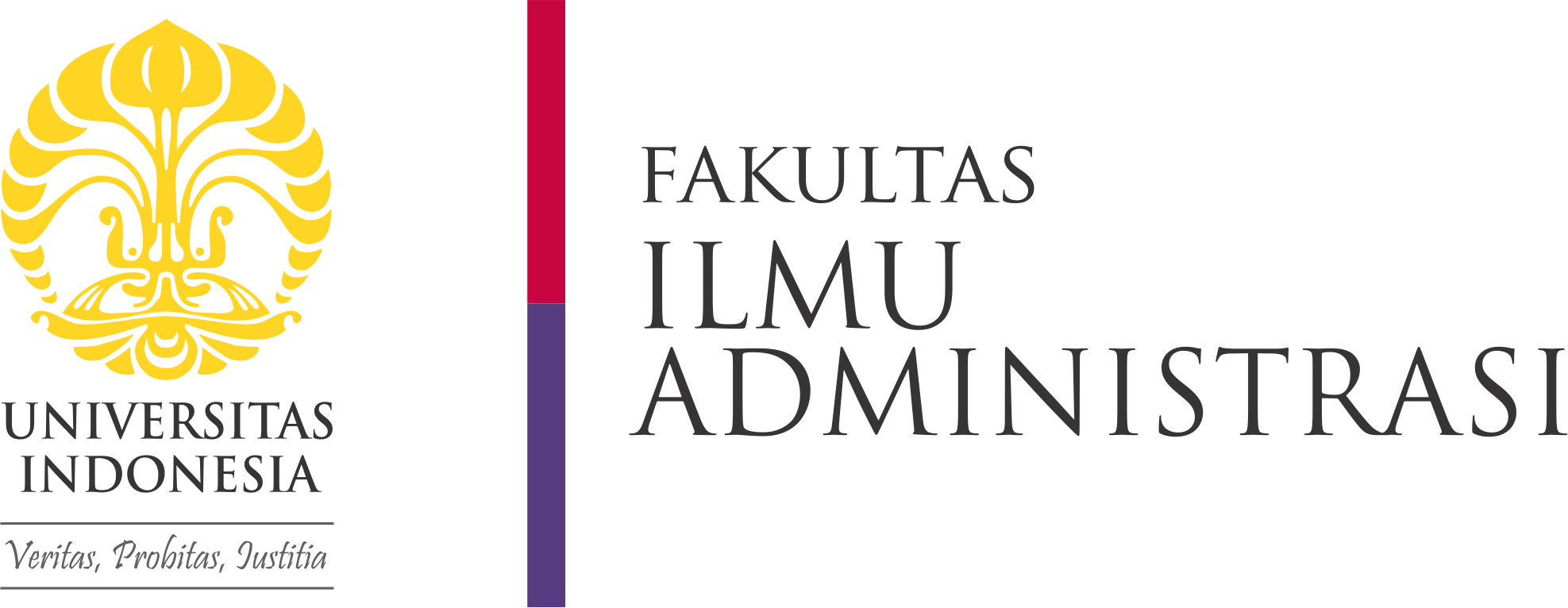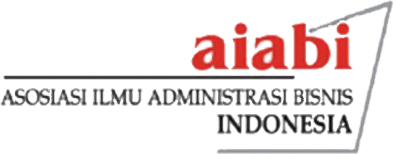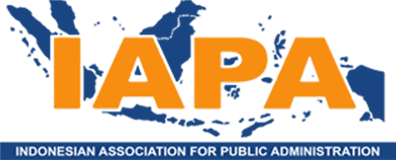Abstract
This paper aims to analyze the perception of involved actors toward collaboration and investigate conditions that motivate actors to collaborate in delivering public services. This study uses pragmatic philosophy that utilizes qualitative data collection. Despite the government as the leading service provider, non-state actors' involved in planning, organizing, and evaluating service delivery. By conducting a focus group discussion, providing an open question survey, and analyzing relevant news, this research emphasizes that public service providers and communities involved in public service delivery perceived collaboration as working with others or cooperating and achieving common goals. The actors’ belief that achieving common goals is the driver to collaboration. The result also found that developing policies and legal framework to strengthen collaboration is essential to sustain the collaboration.
References
Agranoff, R. (2007). Managing within networks: Adding value to public organizations. Washington DC: Brookings Institution Press. Annissa, M. (2019, November 20). Membangun Asa Desa Tuntas Adminduk di Lombok Timur (Achieving Village Purpose of Full Coverage in Civil Registry Service in East Lombok). Retrieved from KOMPAK: https://kompak.or.id/id/article/membangun-asa-desa-tuntas-adminduk-di-lombok-timur Ansell, C., & Gash, A. (2007). Collaborative governance in theory and practice. Journal of Public Administration Research and Theory, 543-571. Bardach, E. (1998). Getting agencies to work together: the practice and theory of managerial craftmanship. Brooking Institution Press. Bryson, J., Crosby, B., & Nabatchi, T. (2006). The design and implementation of cross sector collaborations: propositions from the literature. Public Administration Review, 44-55. Central Bureau of Statistics. (2018). Survei sosial ekonomi nasional (Susenas) (National socioeconomic survey). Jakarta: Central Bureau of Statistics. Civil Registry Office Denpasar City. (2020, September 01). Kerjasama antara Disdukcapil Kota Denpasar dengan Gojek (Cooperation between Disdukcapil Denpasar City and Gojek). Retrieved from Dinas Kependukan dan Catatan SIpil Kota Denpasar: https://www.kependudukan.denpasarkota.go.id/berita/read/24890#! Civil Registry Office Metro City . (2020). Inovasi Pelayanan. Retrieved from Disdukcapil Kota Metro: http://dukcapil.metrokota.go.id/Page/inovasi-pelayanan Communication and Information Agency. (2020, October 5). Gandeng Disdukcapil, Kades Mattiro Ujung tuntaskan pelayanan adminduk warga (Cooperate with Disdukcapil, Kades Mattiro Ujung completed the administrative services of the citizens. Retrieved from Dinas Komunikasi dan Informatika: https://diskominfo.pangkepkab.go.id/index.php/berita/item/1378-gandeng-disdukcapil-kades-mattiro-ujung-tuntaskan-pelayanan-adminduk-warga Conner, T., Nowlin, M., Rabovsky, T., & Ripberger, J. (2015). Cultural theory and managerial values: Examining trust as a motivation for collaboration. Public Administration, 915-932. Daley, D. (2008). Interdisciplinary problems and agency boundaries: exploring effective cross agency collaboration. Journal of Public Administration Research and Theory, 19(3), 477-493. Daswati, Samad, M., & Wekke, I. (2020). Collaborative governance in the management of integrated community shelters post disaster (ICS) in the city of Palu. Indonesian Political Science Review, 5(2), 229-242. Directoral General of Popuation and Civil Registry Ministry of Home Affairs. (2020, 06 19). Keren! 5 Inovasi Dukcapil Masuk Top Sinovik 2020. Retrieved from Dukcapil Kemendagri: https://dukcapil.kemendagri.go.id/berita/baca/538/keren-5-inovasi-dukcapil-masuk-top-sinovik-2020 Dwiastono, R., & Budhi, O. (2019, July 24 ). Pernikahan usia anak di Sulawesi Selatan: 'Berikan ijazah, jangan buku nikah' (Child marriage in South Sulawesi: 'Give a diploma, not a marriage certificate'). Retrieved from BBC News Indonesia: https://www.bbc.com/indonesia/indonesia-49081206 Emerson, K., & Nabatchi, T. (2015). Collaborative governance regimes. Georgetown University Press. Emerson, K., Nabatchi, T., & Balogh, S. (2012). An integrative framework for collaborative governance. Journal of Public Administration Research and Theory, 22(1), 1-29. Esteve, M., Van Witteloostuijin, A., & Boyne, G. (2015). The effects of public service motivation on collaborative behavior: Evidence from three experimental games. International Public Management Journal, 171-189. Gazley, B. (2008). Intersectoral collaboration and the motivation to collaborate: toward an integrated theory. In L. Bingham, & R. O'Leary (Eds.), Big ideas in collaborative public management (pp. 36-54). Armonk, New York: M.E Sharpe. Getha-Taylor, H., & Haddock-Bigwarfe, A. (2014). Public service motivation and willingness to collaborate: An examination in the context of homeland security. Evidence-based HRM: a Global Forum for Empirical Scholarship, 2(1), 80-95. Kapucu, N., Garayev, V., & Wang, X. (2013). Sustaining networks in emergency management: a study of counties in the United States. Public Performance and Management Review, 104-133. Kaufmann, D., Kraay, A., & Mastruzzi, M. (2010). The worldwide governance indicators: methodology and analytical issues. The World Bank. KOMPAK. (2019, May 10). Gerakan tuntas administrasi kependudukan (GERTAK) in Kepulauan Pangkep. Retrieved from Kompak: https://kompak.or.id/id/article/gerakan-tuntas-administrasi-kependudukan-gertak-di-kepulauan-pangkep KOMPAK. (2020). Panduan fasilitasi kuliah kerja nyata tematik adminduk (Guidance of a thematic student study service facilitation in civil registration service). Jakarta: KOMPAK. Kurniawati, I., & Kustulasari, A. (2020). Public value creation by private sector through cross-sector collaboration: A case study of the Gojek Wirausaha Program. Bisnis dan Birokrasi: Jurnal Ilmu Administrasi dan Organisasi, 153-165. Lynn, L., Heinrich, C., & Hill, C. (2001). Improving governance: A new logic for empirical research. Washington DC: Georgetown University Press. Mandell, M., & Steelman, T. (2003). Understanding what can be accomplished through interorganizational innovations the importance of typologies, context, and management strategies. Public Management Review, 197-224. Mu, R., de Jong, M., & Koppenjan, J. (2019). Assessing and explaining interagency collaboration performance: a comparatice case study of local governments in China. Public Management Review, 581-605. Murphy, K. (2015). Does procedural justice matter to youth? Comparing adults' and youths' willingness to collaborate with police. Policing and Society, 53-76. Nikolova, K., Postmus, J., Buttner, C., & Bosk, E. (2020). Working together to protect women and children from domestic violence: Factors influencing willingness to collaborate between organizations. Children and Youth Services Review. Nugraheny, D. (2020, September 09). Lima Keluhan Masyarakat soal Layanan Administrasi Kependudukan, dari Pungli hingga Lambatnya Pencetakan e-KTP (Five Public Complaints about Population Administration Services, from Pungli to Slow Printing of e-KTP). Retrieved from Kompas: https://nasional.kompas.com/read/2020/09/09/21165101/lima-keluhan-masyarakat-soal- O'Flynn, J., & Wanna, J. (2009). Collaborative governance: A new era of public policy in Australia. O'Leary, R., & Bingham, L. (2009). The collaborative public manager: New ideas for the twenty first century. Washington D.C: Georgetown University Press. PANGKEP TV. (2020, January 21). Penerimaan mahasiswa KKN tematik UMI (UMI thematic KKN student admissions). Retrieved from Pangkep TV: https://www.youtube.com/watch?v=Fsm9YnTWB6k Peters, B., & Pierre, J. (2006). Governance, accountability, and democratic legitimacy. In A. Benz, & Y. Papadopoulos (Eds.), Governance and Democracy: Comparing National, European and International Experiences. London : Routledge. Reisig, M., Bratton, J., and Gertz, M., 2007. The construct validity and refinement of process- based policing measures. Criminal Justice and Behaviour, 34 (8), 1005-1028. doi:10.1177/ 0093854807301275 Serajuddin, U., & Hamadeh, N. (2020, July 1). New World Bank country classifications by income level: 2020-2021. Retrieved from World Bank Blog: https://blogs.worldbank.org/opendata/new-world-bank-country-classifications-income-level-2020-2021 Statistics of Pangkajene and Island Regency. (2018). Kabupaten Pangkajene Kepulauan Dalam Angka (Regency of Pangkajene Islands In Numbers). Pangkajene: Statistics of Pangkajene and Island Regency. Sullivan, H., & Skelcher, C. (2002). Working Across Boundaries: Collaboration in Public Services. Macmillan International Higher Education. The Ombudsman Republic of Indonesia. (2019). Ringkasan eksekutif: Hasil penilaian kepatuhan terhadap standar pelayanan penyelenggara pelayanan sesuai dengan Undang-Undang Nomor 25 Tahun 2009 tentang Pelayanan Publik (Executive summary: Results of assessment of compliance with service standards of service providers in accordance with Law No. 25 of 2009 on Public Services). Jakarta: Ombudsman RI. Thompson, A., & Perry, J. (2006). Collaboration processes: Inside the backbox. Public Administration Review, 20-32. Thompson, G., Frances, J., Levacic, R., & Mitchell, J. (Eds.). (1991). Markets, hierarchies and networks: The co-ordination of social life. London: Sage. UNICEF. (2020). UNICEF global databases. UNICEF.
Recommended Citation
Rahmayanti, Krisna Puji
(2021)
"The Perception of Actors Toward Collaboration in Public Services: Evidence from Civil Registration Services Innovation in the Pangkajene and Island Regency,"
BISNIS & BIROKRASI: Jurnal Ilmu Administrasi dan Organisasi: Vol. 28:
No.
1, Article 5.
DOI: 10.20476/jbb.v28i1.1297
Available at:
https://scholarhub.ui.ac.id/jbb/vol28/iss1/5






